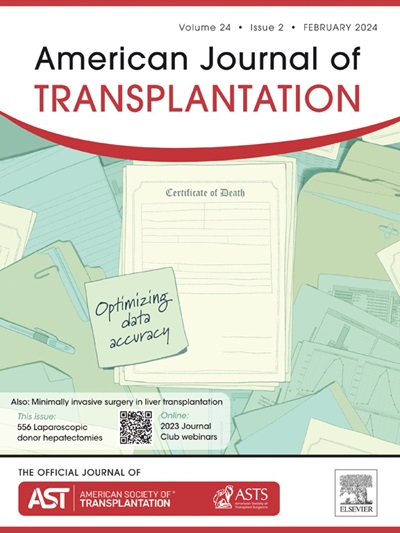对卡波济肉瘤疱疹病毒 (KSHV)/ 人类疱疹病毒-8 (HHV-8) 感染进行血清学筛查和分子监测,以便早期识别和有效治疗实体器官移植受者的 KSHV 相关炎症细胞因子综合征 (KICS)。
IF 8.2
2区 医学
Q1 SURGERY
引用次数: 0
摘要
实体器官移植(SOT)受者中的卡波西肉瘤疱疹病毒/人类疱疹病毒-8(HHV-8)肿瘤性和非肿瘤性疾病可能危及生命。我们评估了 2011 年至 2023 年连续 SOT 患者中供体(D)和受体(R)的 HHV-8 感染血清流行率、HHV-8 传播/复活的发生率以及 HHV-8 相关疾病(包括卡波西肉瘤疱疹病毒相关炎性细胞因子综合征(KICS))的临床特征、管理和预后。在接受筛查的 1349 名供体和 1856 名受体中,HHV-8 血清阳性率分别为 3.3% 和 8.4%(p本文章由计算机程序翻译,如有差异,请以英文原文为准。
Serologic screening and molecular surveillance of Kaposi sarcoma herpesvirus/human herpesvirus-8 infections for early recognition and effective treatment of Kaposi sarcoma herpesvirus-associated inflammatory cytokine syndrome in solid organ transplant recipients
Kaposi sarcoma (KS) herpesvirus/human herpesvirus-8 (HHV-8) neoplastic and nonneoplastic disease in solid organ transplant recipients can be life-threatening. We evaluated the seroprevalence of HHV-8 infection among donors (D) and recipients (R), the incidence of HHV-8 transmission/reactivation, and the clinical characteristics, management, and outcomes of HHV-8-related diseases, including KS herpesvirus-associated inflammatory cytokine syndrome (KICS), in consecutive SOT patients from 2011 to 2023. HHV-8 seroprevalence was 3.3% in 1349 donors and 8.4% in 1856 recipients screened (P < .0001). In the D+/R− group (n = 49), 13 patients developed HHV-8-related diseases: 7 liver recipients had KICS, and 1 lung recipient had KS with subsequent KICS. Four KICS patients treated with rituximab survived, whereas the 3 patients not treated with rituximab died. Within the D−/R− group, of 5 (0.3%) patients with non–donor-derived primary HHV-8 infection, 3 liver recipients developed KICS. Of the R+ patients (n = 155), 3 developed KS. In our cohort, 25/944 (2.6%) liver transplant recipients had a primary HHV-8 infection, and 10 of them (40%) developed KICS; 40% (4/10) of HHV-8 seropositive heart transplant recipients developed reactivation, and 2 of them (50%) had fatal KS. Serologic screening and molecular surveillance of D+/R− patient groups facilitate early recognition and effective therapy of KICS.
求助全文
通过发布文献求助,成功后即可免费获取论文全文。
去求助
来源期刊
CiteScore
18.70
自引率
4.50%
发文量
346
审稿时长
26 days
期刊介绍:
The American Journal of Transplantation is a leading journal in the field of transplantation. It serves as a forum for debate and reassessment, an agent of change, and a major platform for promoting understanding, improving results, and advancing science. Published monthly, it provides an essential resource for researchers and clinicians worldwide.
The journal publishes original articles, case reports, invited reviews, letters to the editor, critical reviews, news features, consensus documents, and guidelines over 12 issues a year. It covers all major subject areas in transplantation, including thoracic (heart, lung), abdominal (kidney, liver, pancreas, islets), tissue and stem cell transplantation, organ and tissue donation and preservation, tissue injury, repair, inflammation, and aging, histocompatibility, drugs and pharmacology, graft survival, and prevention of graft dysfunction and failure. It also explores ethical and social issues in the field.

 求助内容:
求助内容: 应助结果提醒方式:
应助结果提醒方式:


